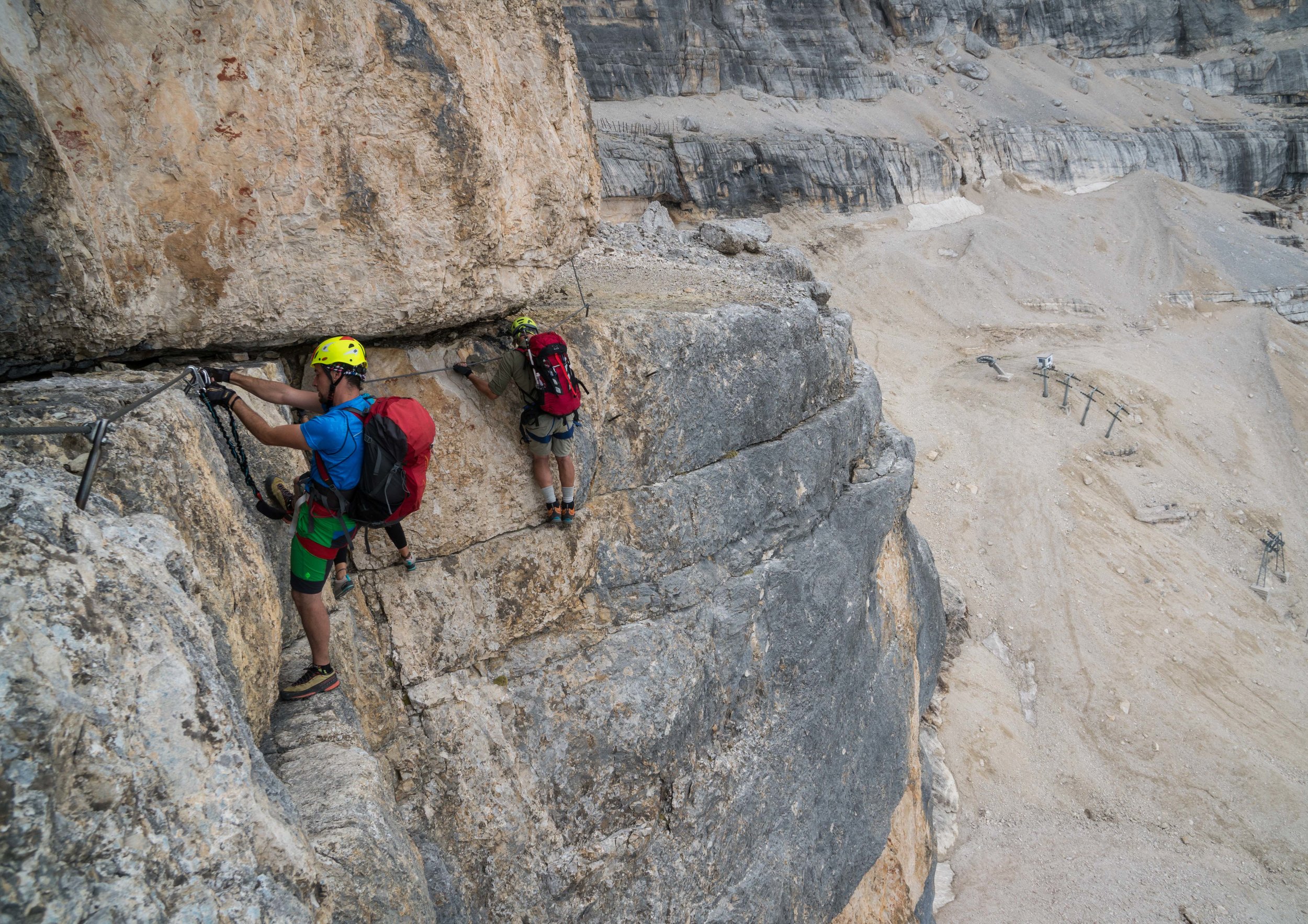Via Feratta...what is it?
/Is it climbing? Is it trekking? Nope, it’s via feratta!
Via feratta, Italian for the “Iron road”, is just plain fun. But what exactly is it? Via Feratta is climbing and hiking an exposed mountain route via hand and footholds as well as ladders, iron steps, pegs and even suspension bridges. All the while you are clipped into steel cables for protection from falling into the abyss. Very popular in the Alps of Europe, it has only recently begun to catch on here in the United States.
making some moves while securely clipped in
It was originally developed on the front lines of world war one during which the Italians and the Austrians were fighting a gruesome war high up in the peaks of the Dolomite mountains which is now all in Italy. There was a need to move troops around, and through, the mountain faces out of the direct line of enemy fire and also in bad weather. So they created “iron paths” up sheer mountain faces using pegs and ladders. The troops would even dig extensive tunnels through the mountain faces underneath enemy positions and then detonate explosives underneath their foes. Out of this insanity the sport of via feratta was born. Before WWI there were rudimentary forms of via feratta throughout the Alps.
a typical via feratta suspension bridge
The way it works in the modern world is that you wear a climbing harness with two full strength elastic cords attached. At the end of the cords are locking carabiners designed specifically for via feratta that are easy to clip and unclip. In addition, you should have a load limiting system that are incorporated into this system. As you go along, you clip both carabiners into the cable which about every 4-10 feet is securely connected into the rock with pegs or bolts. As you come to one of the connection points you unclip and clip one carabiner at a time so you are always clipped in and protected. In the event of a fall, you will fall to the last connection point and the system will stop you with a dynamic catch. It’s kind of like leading a sport climb on rock, but on very easy terrain. Even though the fall may be “only” 4-16 feet, falling is something you don’t necessarily want to do because there is usually something to hit along the way. But…with the protection system it prevents the consequences from being catastrophic. On a guided via feratta, your guide will also provide additional belayed protection with a rope to help reduce the risk that you’ll injure yourself from even a small fall.
As for other gear, A helmet is pretty much mandatory for many obvious reasons. The best footwear is sticky rubber approach shoes that are comfortable to hike longer distances in but have the same sticky rubber found in technical climbing shoes. Other than that, all you need is some extra clothing layers, a hydration system or water bottles and a small pack (28 – 45 liters) to carry it all in.
High above corvara in the dolomites
The Dolomites are still the epicenter of via feratta worldwide with via feratta routes spread throughout the region. The Dolomiti peaks are the perfect venues with narrow pathways and ledges and sheer drop offs sometimes over a 1000 feet. You’ll also find suspension bridges at dizzying heights and near vertical climbing sections, sometimes even a bit overhanging. Like the rest of the Alps, the Dolomites also have an extensive alpine hut system which add to the adventure. In the United States the concept has only recently begun the catch on. Ski areas, such as Jackson Hole, Wy., Squaw Valley, Ca., and most recently, Mammoth Mountain, Ca. have begun to install via feratta routes on their cliff faces as a way to attract summer visitors.
Via feratta is to alpine climbing what bouldering is to rock climbing. You can launch off on huge alpine rock routes with nothing more than some approach shoes, a helmet and harness. Via feratta allows people without climbing experience to climb highly exposed alpine style rock climbing routes they would not dare attempt otherwise. Of course, you still need to be very fit and have experience hiking on very uneven terrain. Even experienced alpine and rock climbers tend to really enjoy the freedom of movement on big via ferattas. For them, it’s simply an unencumbered way to enjoy big mountain routes without the need for a lot of gear.
An exposed traverse high above Cortina d’Ampezzo, Italy.
Some via ferattas are well over 3000 feet in vertical rise and can be all day affairs while others are truly beginner routes and may only take 45 minutes. On some of the most difficult via feratta routes you might find the climbing to be akin to 5.10 in difficulty while others are no more than very exposed strolls protected by a wire. In places with extensive feratta routes like the Dolomites there are guidebooks and rating systems to help you sort it out.
Via Feratta is a great way to experience the dizzying heights and pure adventure on big alpine rock routes without investing the years of practice normally required for such endeavors. All you need is good fitness and an adventurous attitude. Go give it a try!
Check out our new Dolomites Via Feratta Hut to Hut trip for September 2019











